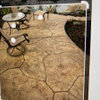How to Attach Ledger to Concrete Wall?
java_man
17 years ago
Related Stories

KNOW YOUR HOUSEKnow Your House: The Basics of Insulated Concrete Form Construction
Get peace and quiet inside and energy efficiency all around with this heavy-duty alternative to wood-frame construction
Full Story
INDUSTRIAL STYLERoom of the Day: Concrete Block Goes Chic in a Living Room
Designers put a fresh face on a workaday material in this Washington, D.C., condo
Full Story
KITCHEN COUNTERTOPSKitchen Counters: Concrete, the Nearly Indestructible Option
Infinitely customizable and with an amazingly long life span, concrete countertops are an excellent option for any kitchen
Full Story
MATERIALS10 Cool Things to Do With Concrete in Your House
Humble concrete is being reinvented in everything from bathroom fixtures to lampshades
Full Story
GREEN BUILDINGHouzz Tour: See a Concrete House With a $0 Energy Bill
Passive House principles and universal design elements result in a home that’ll work efficiently for the long haul
Full Story
FLOORS5 Benefits to Concrete Floors for Everyday Living
Get low-maintenance home flooring that creates high impact and works with home styles from traditional to modern
Full Story
LANDSCAPE DESIGNGarden Walls: Gabion Evolves From Functional to Fabulous
The permeable rock-, concrete- or glass-filled steel cages are showing up as retaining walls, planters, benches and more
Full Story
GARDENING AND LANDSCAPING6 Ways to Rethink Your Patio Floor
Figure out the right material for your spring patio makeover with this mini guide to concrete, wood, brick and stone
Full Story
MATERIALSRaw Materials Revealed: Brick, Block and Stone Help Homes Last
Learn about durable masonry essentials for houses and landscapes, and why some weighty-looking pieces are lighter than they look
Full Story
GARDENING AND LANDSCAPINGHow to Pick a Nice Wall for Your Garden Room
Made by hand, prefab or growing from the ground, garden walls are key landscaping elements. Here's what to think about for your yard
Full Story







brickeyee
john_hyatt
Related Professionals
Atlantic City Decks, Patios & Outdoor Enclosures · Jeffersonville Decks, Patios & Outdoor Enclosures · Oswego Decks, Patios & Outdoor Enclosures · Harrisburg Home Builders · Salisbury Home Builders · Beaumont Flooring Contractors · Leland Flooring Contractors · Riverhead Flooring Contractors · Severna Park Flooring Contractors · Westlake Flooring Contractors · Winchester Flooring Contractors · Cocoa Flooring Contractors · Columbus Siding & Exteriors · Richmond Siding & Exteriors · Worcester Siding & Exteriorsjava_manOriginal Author
brooklyndecks
srercrcr
brickeyee
brooklyndecks
brickeyee
brickeyee
srercrcr
john_hyatt
brickeyee
srercrcr
brickeyee
brooklyndecks
srercrcr
irishbrewer
irishbrewer
srercrcr
brickeyee
irishbrewer
derekjoel_gmail_com
Melm813_yahoo_com